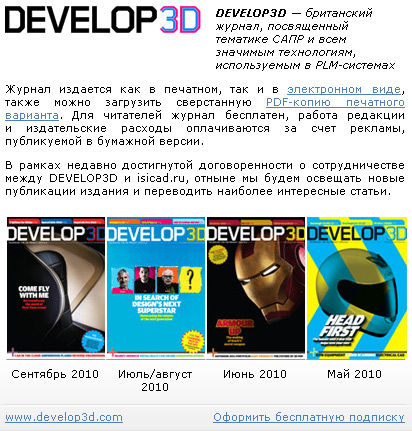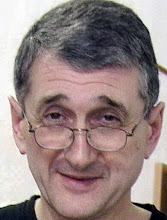
12/24/2010
12/23/2010
Autodesk, DS, Geomagic, IBM, Kubotek, PTC, Siemens, and other at COFES-Israel

There were fourteen 12-minutes talks (including opening and concluding speeches) sectioned into four sessions. 45-minute breaks enabled some interesting informal meetings, for example I succeeded to talk to those 5 persons with whom I had had plans to meet.

All the presentations were quite interesting, but I would give the first three places to correspondingly: Brian Shepherd (PTC), Chris De Neef (Fast Track Consulting, Belgium), and Eitan Yudilevich (BIRD Foundation, Israel).

My brief characteristics of all the presentations along with 17 photos are given in the isicad.net article "Innovations Should be More Practical, Less Political. COFES-Israel Forum Report". There one can also read my comparison of COFES-Israel and COFES-Russia.
11/27/2010
Francis Bernard, the Founder of DS and Inventor of CATIA

11/19/2010
A More or Less Optimistic Update on BIM
11/16/2010
A Hot Discussion around BIM at isicad.ru

11/02/2010
Oleg Shilovitsky unveils his Inforbix to arrange and maintain mixtures of chaotic product data
10/29/2010
Russian CAD/PLM Market: May-Oct, 2010

If you don't receive by e-mail my quaterly overviews of the Russian CAD/PLM market, you can take a look at a web variant of the today's report at isicad.net. Below I put an introduction for this paper.
isicad.ru has no data from vendors about current volumes of their sales but general situation at the Russian CAD/PLM market is characterized by:
- nobody mentions crisis,
- everybody publishes news about new contracts and organizes big conferences and seminars everywhere in Russia.
My own formulations of companies' news in few words are as follows:
- 1C with its huge small-ERP reselling network and together with APPIUS is getting closer and closer to PLM,
- ASCON strongly emphasizes its SaaS / cloud service but does not forget improving its MCAD,
- Autodesk CIS is more and more improving communication with mass Russian market,
- Dassault Systemes promotes its social networking and continues working with big industries,
- LEDAS reconfigures its business and persistently moves towards implementation of direct modeling and its applications,
- Nanosoft continues promotion of its native free platforms but balances this by more reselling of Western products,
- PTC is enhancing its (already strong) distribution network,
- Siemens PLM promotes its ST3 and continues working with big industries.
- Top Systems announced that they have a full-scale world-class PLM.
See the whole paper with a dozens links here.
10/26/2010
About DS Marketing: The Road to CATIA V6 and SolidWorks through Facebook
- Some customers still use CATIA V5 and even CATIA V4. What are your thoughts about CATIA V6 market history as Vice President, Global Marketing & Education?
- In Russia SolidWorks is considered as a mature solution with a rich set of features, probably, the best in its class. Perhaps, there is a big potential for SolidWorks market growth (by the way, it is for sure used illegally by many engineers). Why Dassault Systemes does not endeavor to promote SolidWorks as much as CATIA, in particular, has no SolidWorks representative office?
- CATIA Geometric Modeler (CGM) is a new product on the market although it has been used internally in CATIA for a long time. What is the reason to make it a public product now?
- Certainly CAA licenses are less popular than CATIA itself. Do you have a specific strategy to sell CAA licenses in rather small Russian market?
- A significant part of Russian industry is giant factories inherited from the USSR. Do you use any specific ways to deal with their bureaucratic apparatus and style of decision-making?
- What is an impact of social networks on marketing and sales – in Russia and worldwide? Are social networks able to penetrate the world of big corporations or, maybe, they are useful for selling CATIA to smaller customers?
- Was your experience at Oracle useful at Dassault Systemes? Is it hard to “switch” from ERP to CAD or these areas have a lot in common? Do you think that business processes in all world-level corporations are just the same?
- Is Dassault Systemes’ 3dvia.com service commercially successful?
LEDAS about ST-3 from Siemens
10/12/2010
All about AutoCAD for Windows, Mac, Linux, clouds, and other
10/08/2010
DEVELOP3D makes the first step to the Russian market with isicad.ru

10/07/2010
What browsers are preferred in the Russian CAD market?

10/03/2010
What could be seen and heard at COFES-Russia / isicad-2010
Today I posted a relatively short English report about the event - albeit covering all parts of the event as well as containing 50+ characteristic photos and links to all video and audio (mostly in Russian): "What could be seen and heard at COFES-Russia/isicad-2010". This is a translation of the original, I beg your pardon for not yet corrected and polished English. All kinds of feedback are welcome.
Also the agenda of the event at its English website has just been enriched by inserting links to videos, audios, and pdfs of presentations. Access to the Forum video and audio materials is free. Access to the copyrighted presentations on the isicad web sites is available through login and password, which are passed to participants of the Forum only. The authors can of course publish their presentations on their own.
9/26/2010
Deelip Menezes and Martyn Day at LEDAS and around
25 September Deelip Menezes and Martyn Day spent in Novosibirsk: at LEDAS office and around. In his blog, Deelip describes this day (Part 1, Part 2, Part 3) and says:
"Martyn Day from DEVELOP3D and I are in Novosibirsk in Siberia to visit LEDAS, a very interesting Russian software research and development company. We spent the entire day at LEDAS and learned a great deal about them, a lot of which was highly classified and not for public consumption. I intend to write more about the company, its technologies and products after I get back to India".
What I can add to Deelip's posts are a few photos and two video clips that I definitely recommend to see:).
Before the beginning of a series of seminars.
Guests listen to an overview of a LEDAS application with advanced features of direct modeling to be released in December
It was especially nice when guests began to passionately argue among themselves on how to develop business of LEDAS
On our way to Armenian restaurant "Anait", Deelip is still interested in discussing with me the LEDAS pricing policy and...
... variational direct modeling - with Dmitry Ushakov.
Deelip, just do it - number 2! (see number 1)
This does not mean that after 57% Armenian vodka Deelip could not keep his spoon: this is just Siberian hospitality.
The main hero of the two video clips below is the financial director of LEDAS, a man with a lot of talents - Evgeniy Kuznetsov.
COFES-Russia / isicad-2010 was held on 21 September



You can take a look at the initial portion of photoes just publihed here.
How COFES-Russia and Autodesk Moscow Forum were prepared

Lobby bar of the Borodino hotel: Vladimir Malukh, Deelip Menezes, Oleg Shilovitsky, David Levin, Brad Holtz. Reflections on the fate of the world market of CAD/PLM 
Deelip really loves the Moscow subway. His post about it looks like a poem. 
Brad Holtz and Oleg Shilovitsky also love the Moscow subway, at least on Sunday when it's not overcrowded
Brad Holtz explains Oleg Shilovitsky a link between A.Pushkin and engineering software.
Brad Holtz is pondering over his forthcoming presentation at the Autodesk Moscow Forum. He had just listened to the recommendations of Anastasia Morozova, Field Marketing Area Team Manager Russia and CIS
Deelip, just do it!
9/13/2010
Discussing LEDAS’ heavy technological karma...
9/12/2010
ASCON Unveils the First Ever CAD-on-the-Cloud
9/06/2010
My vision of the plenary session at isicad-2010/COFES
In these remarks I would like to review the plenary (morning) session of isicad-2010 / COFES-Russia.
I must confess that initially we had hot discussions with Brad Holtz about the style of this event. Brad reasonably wished it to be a COFES Forum, and I was trying to explain that Russian vendors or (to be more precise) vendors in Russia are more used to workshops, which enable to supply certain vendor information to the audience (primarily – tell your clients about your solutions), while forums as some kind of meetings to discuss problems common to all attendees raise some doubts in the eyes of our vendors … The ends were gained by a kind of art: isicad-2010 is boldly called Forum and COFES-Russia goes by seminar – just in case... :). I take the liberty to further on refer to our common event as the Forum.
Jokes aside, overall the event has good chances to become a true Forum. First, the Working Groups and the concluding Round Table (combined with a press-conference) undoubtedly are the sites for forum discussions. Second, the final composition and format of plenary sessions justify the Forum style - if not completely, than certainly to a considerable degree. To be able to include maximum possible number of conceptual talks, we have drastically cut down the average time for presentations, introducing three options: 5, 10 and 15 minutes (excluding the Invited Talk). It is implied that to outline the essential ideas and concepts, define global trends, specify generally important problems, and the like, does not require too much time, unlike describing features of a new product or its new version. I’d like to emphasize that all speakers and companies that they represent showed full understanding of this approach and did not insist on extended time for their talks.

See also Round Tables and Their Moderators... and Media at COFES-Russia... .




















